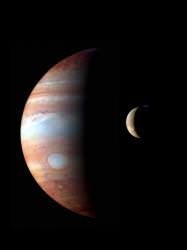Written by Fraser Cain

Remember when New Horizons sped past Jupiter on its way to Pluto. It kept its cameras rolling during the flyby, and captured hard drives full of data. Researchers have had a chance crunch through some of this data, and announced a series of discoveries this week: polar lightning storms, clumpy rings, volcanic eruptions on Io, and more.
New Horizon's goal may be Pluto, but it's got some time to kill between now and then. Might as well gather some science along the way. The spacecraft sped past Jupiter on February 28, 2007, picking up a valuable gravity assisted speed boost. It was the 8th spacecraft to make a close encounter with Jupiter, and just those before, it revealed valuable new insights into Jupiter and its satellites.
When the spacecraft was approaching Jupiter, mission planners carefully planned out 700 observations they wanted New Horizons to make. In fact, this is twice the number planned for the brief flyby of Pluto in 2015. They focused their collection on outstanding scientific issues that needed further investigation; to try and give scientists some kind of closure to mysteries opened up by previous spacecraft flybys.
Top on the list is Jupiter's weather. New Horizons observed the planet's clouds using visible light, infrared and ultraviolet. They saw ammonia clouds welling up from deeper down and heat-induced lightning strikes in the polar regions - the first polar lightning seen apart from Earth.
The spacecraft also focused in on Jupiter's tenuous rings. The detailed observations revealed clumps of material that could indicate there was a recent impact inside the rings. Just like Saturn, Jupiter has tiny moons that serve as shepherds, keeping the ring material together.
New Horizons also focused its cameras on Jupiter's volcanic moon Io. The spacecraft observed 11 different volcanic plumes of varying size, and could see 36 hotspots on the moon in the infrared spectrum. Three of these volcanoes were seen for the very first time.
Finally, the spacecraft measured the magnetic tail that trails behind Jupiter. New Horizons saw material ejected by Io moving down the tail in large, dense, slow-moving blobs, captured in the magnetic field.
New Horizons is now halfway between the orbits of Jupiter and Saturn, and more than 1.19 billion km (743 million miles) from Earth.
Original Source: JHU APL News Release



No comments:
Post a Comment